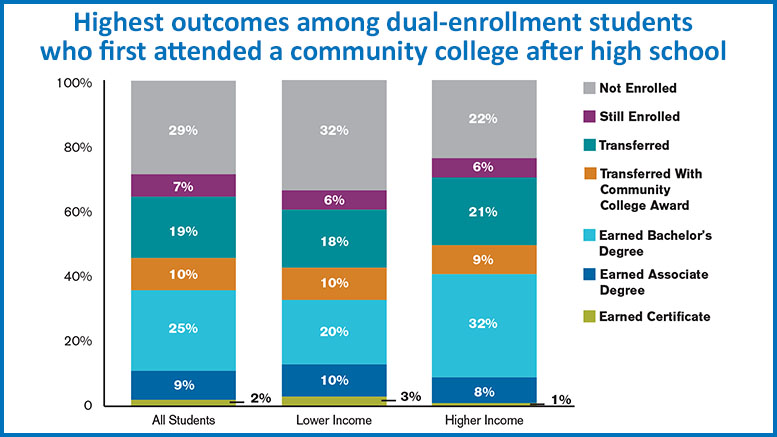Nearly half of dual-enrollment students who first went to a community college earned a postsecondary credential five years after high school, according to a new report.
About 46 percent of students who started dual enrollment at age 17 and first matriculated at a community college between ages 18 and 20 completed a degree or certificate five years after high school, says the study from the Community College Research Center at Columbia University and the National Student Clearinghouse Research Center. About 20 percent transferred to a four-year institution but had not earned a credential after five years, and 7 percent were still enrolled at a community college.
There were also significant gaps among lower- and higher-income dual-enrollment students who later earned a college credential, the report said.
The study noted, as have previous reports, that credential completion and program structures vary among states. The rates for attaining any college credential — whether at a two- or four-year college — among students in the study ranged from 28 percent to 64 percent, with Florida, Minnesota and Mississippi passing the 60-percent mark.
For the study, researchers tracked for six years more than 200,000 high school students who first took a community college course in fall 2010.
Other findings include:
- 88 percent of community college dual-enrollment students continued on to college after high school.
- 15 percent of new community college students in fall 2010 were dual-enrollment high school students, ranging from 1 percent in Georgia to 34 percent in Kentucky. (The study noted that the number has likely grown since then.)
- Nearly two-thirds of community college dual-enrollment students were from low- or middle-income families, which is about the same proportion as students who start in a community college after high school.
- 64 percent of former community college dual-enrollment students who first enrolled at a four-year college after high school completed a degree within five years.
Addressing the challenges
Despite the promising numbers, college advocates point out that dual enrollment has its challenges. There are issues such as who will teach the programs (state and accreditation rules often regulate teacher requirements), whether the courses are for college credit and who pays for it.
Successful dual-enrollment programs begin with strong, collaborative partnerships between community colleges and their local K-12 school system, and they require clearly articulated agreements that spell out each entity’s responsibilities.
Dual enrollment has been an issue that the American Association of Community Colleges and AASA, The School Superintendents Association have focused on through a series of meetings to allow members of both organizations to share promising practices and examine challenges.
In November, the two associations will hold another joint meeting, this one focused on college readiness.

